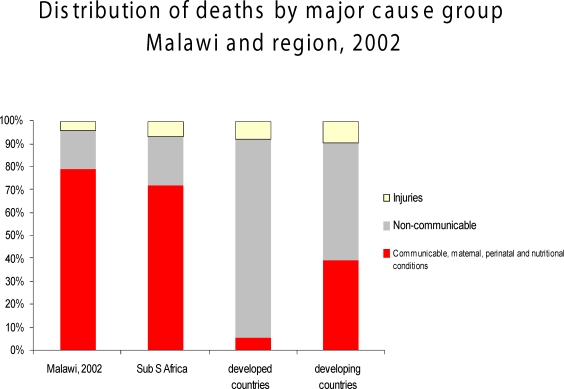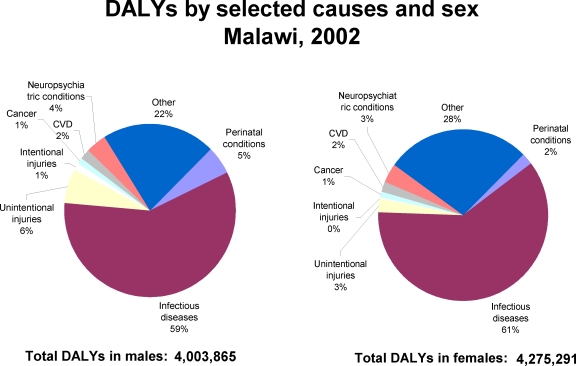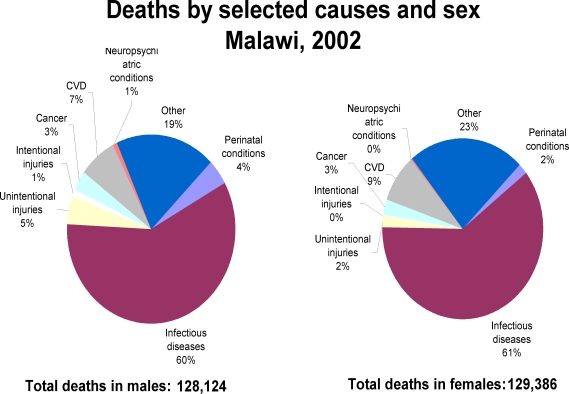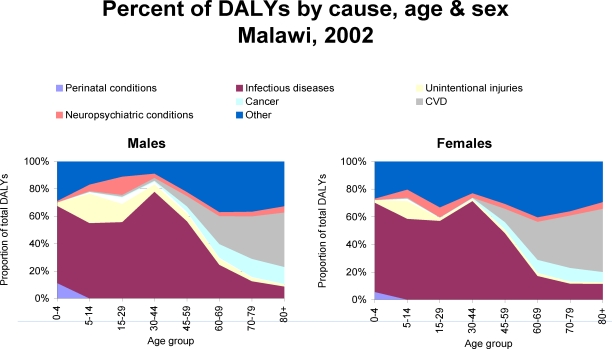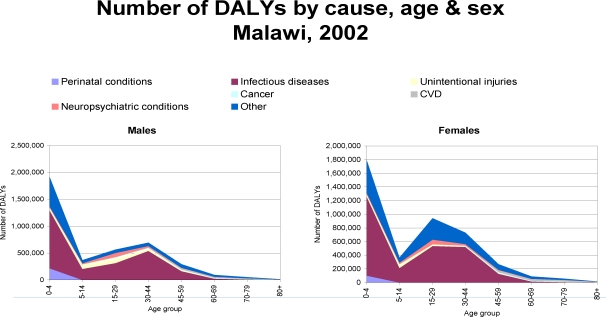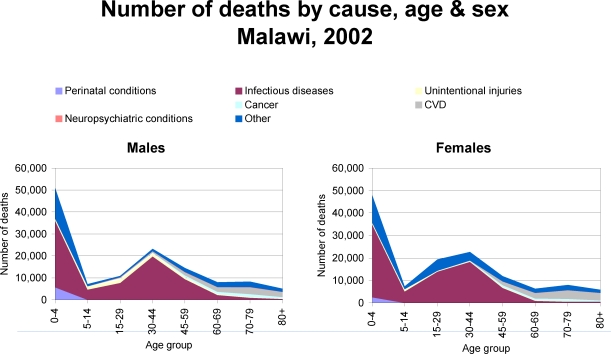Background
This chapter provides an overview of the epidemiology of Malawi. It offers estimates of incidence and prevalence of all major diseases and disease specific death rates. It also ranks the top diseases according to these rates and provides an estimate of the risk factors involved.
The World Health Organisation (WHO) has developed the use of a measure 1, Disability Adjusted Life Years (DALYs), to help calculate the burden of disease, and has produced estimates for individual countries within sub-regions of the world 2. These calculations are based on best estimates of incidence, prevalence and mortality data of the country in question.
A study of the contribution of diseases to the burden of disease in a resource scarce country such as Malawi can also assist priority setting and the choice of an essential health care package (EHP).
This chapter reports on the WHO results and compares WHO estimates with known local surveys of mortality and morbidity. The chapter discusses the limitations of the estimates. The results can help to prioritise public health interventions. The incidence and prevalence rates can provide health professionals with “best available” estimates for Malawi.
Methods
WHO methodology
Estimates are available from the World Health Organisation (WHO) for 2002 of DALYs, years of life lost (YLLs), years lost due to disability (YLDs) and death rates for Malawi and the sub-region, AFRO E, which includes Malawi as well as other countries in southern and central Africa 3.
Deaths
Overall mortality
For member states without a vital registration system as is Malawi, WHO uses other sources of adult mortality such as survey and census data to estimate the level of adult mortality. For under-five mortality, again, all available survey and census data are assessed, adjusted and averaged to estimate the probable trend in child mortality over the past few decades. For Malawi WHO used data from Census 77, Census 87, Census 98, Demographic and Health Survey 92, Demographic and Health Survey 2000, Family Formation Survey 84, National Demographic Survey 82 and the Population Change Survey 70. A life table for Malawi is then constructed providing the number of deaths by age and sex in 2002 3.
Cause specific mortality
The number of deaths, by age and sex, provides an essential “envelope” which constrains individual disease and injury estimates of deaths. Competing claims for the magnitude of deaths from various causes must be reconciled within this envelope. The sum of deaths from all specific causes for any sex-age group must sum to the total number of deaths for that age-sex group.
The World Health Organization contacts member states directly on a routine basis to obtain their latest data on cause-of-death from their vital registration sources. In the absence of a vital registration system, countries are requested to submit data from other reliable sources. Those data submitted by member states become part of WHO's unique historical data base on causes of death which contains data as far back as 1950.
In the case of WHO African region where good vital registration data is existent for only three countries, a regional model pattern of specific causes of deaths is constructed using vital registration data from urban and rural South Africa. Based on this model WHO then uses data provided by member states, together with all available other sources of information on causes of death, to estimate death rates by age and sex for underlying causes of death as defined by the ICD classification rules. These death rates are applied to the UN Population Division estimates of the de-facto resident population for 2002 to give numbers of expected deaths by cause for each Member State. (Annex 1 provides a table of population estimates and a population pyramid for Malawi).
Morbidity
WHO uses disease registers, population studies, epidemiological surveys and health facility data, adjusted for each country using estimates from WHO/UN programmes such as HIV/AIDS and child nutrition.
Calculation of DALYs
DALYs have been calculated using the standard formula and central assumptions used by WHO4. The formula calculates the YLLs from the number of deaths for each age group and sex for each main disease using a discount rate of 3% and weighting each year of life lost according to age. YLDs are calculated using a similar age weighting and discount rate of 3% and disability weights published by WHO. A combination of YLLs (representing premature deaths) and YLDs (representing years with a disability) produce the total burden of disease for each age group and disease expressed in DALYs.
Risk factors
The standard approach in epidemiology and used by WHO for estimating the health effects of a risk factor such as poor sanitation, is to calculate the attributable fraction of a disease or injury due to the risk factor as a function of the prevalence of exposure (P) and the relative-risk (RR) compared to the non-exposed group. The basic statistic in such an “exposure-based” assessment is the attributable fraction (AF), defined as the percentage reduction in disease or death that would occur if exposure to the risk factor was reduced to zero, and is calculated by equation
The fraction of burden from a cause (disease or injury) that is attributed to a risk factor (AF) can be multiplied by the total burden (B) due to that cause to obtain the attributable burden (AB), i.e. AB = AF × B.
This has been done by WHO for developing countries including Malawi and these AFs have been used to calculate the proportion of the overall burden of disease to which common risk factor contribute. (www.who.int/whr/2002/annex/en/index.html).
Local data
Deaths
Local mortality data for maternal and perinatal death rates have been taken from the Demographic Health Survey (DHS) undertaken in 20005. Road traffic accident death rates have been taken from the Africa Road Safety Review of 20006. The most recent (2003) HIV antenatal surveillance prevalence rates have been adjusted for the differences found between antenatal testing and community surveys in Karonga, a district in Malawi7. These have been used to calculate HIV deaths using projections produced by UNAID's EPP and Spectrum software 8.
To avoid double counting, it has been assumed that a sixth of maternal deaths as estimated in the Demographic and Health Survey of 2000 (DHS 2000) are HIV/AIDS deaths. This proportion has been estimated in the following way. Up to a third of pregnancies are HIV positive so this can be considered the upper limit of HIV related maternal deaths. A maternal mortality audit in the southern region of Malawi has found a third of maternal deaths are indirect (not directly caused by obstetric problems) of which a quarter are thought to be HIV related. The lower limit of HIV related maternal deaths is therefore a twelfth. A sixth, used in this chapter, is midway between these two limits. These have been included as HIV deaths and excluded as maternal deaths.
Deaths in health institutions are recorded routinely in the Health Management Information System (HMIS) 9.
WHO estimates of deaths are compared to the National Statistics Office projections for 2002, found on the NSO website.
Morbidity
The Integrated Disease Surveillance and Response (IDSR) reporting system provides data on the incidence of immunization related and other diseases. Malawi has high immunisation programme coverage. Very few measles, pertussis or polio cases have been reported. Estimates of new HIV cases are derived from the antenatal surveillance surveys using EPP and Spectrum. HMIS reports on disease specific patient attendances and admissions. The rates for malaria reported as attending a health facility have been used (national incidence of 730/1000 for under 5 year olds) and adjusted upwards to take into account the fact that only a proportion (26%) of fever cases reported in the DHS2000 are taken to a health facility and adjusted downwards to take into account the fact that only 21% of fever cases are actually due to malaria as found in a local survey in Blantyre, Malawi.
DHS 2000 reports rates for childhood malnutrition and diarrhoea prevalence5. Recent prevalence surveys are available for schistosomiasis10, filariasis associated hydrocoele and lymphoedema11, anaemia12, soil-transmitted helminths10 and blindness13.
Results
Comparing WHO and local data
Deaths
The rates of the common causes of death as recorded in HMIS have been compared to those provided by WHO and none are found to be in excess of these, so the WHO death rate estimates have been used on the premise that most deaths in Malawi occur outside a health facility.
WHO estimates of deaths for Malawi in 2002 are higher than projections provided by the National Statistics Office (NSO) based on the 1998 census and projected forward to 2002 (Table 1).
Table 1.
A comparison of WHO and National Statistics Office estimates of deaths in Malawi 2002
| Malawi 2002 | NSO* | WHO |
| Number of deaths - all ages | 223,110 | 257,510 |
| Deaths under 5 years of age | 80,874 | 99,133 |
National Statistics Office
Incidence and prevalence
The estimates used by WHO can be compared to recent surveys conducted in Malawi. WHO estimates are either very similar or somewhat higher than data from local sources (Table 2). The discrepancy concerning AIDS deaths and maternal mortality are particularly high. See individual chapters for possible explanations.
Table 2.
A comparison of Malawi 2002 incidence and prevalence rates used by Global Burden of Disease (GBD) WHO Unit and estimates from local surveys
| Disease | Age group | GBD | Local | Local Source (reference) | Comment |
| Incidence per 1000 | |||||
| Diarrhoea | 0–4 | 5154 | 4570 | DHS2000 (4) | |
| Cataract | all ages | 2.7 | 3.8 | Nkhoma blindness prevention survey (13) | 1 |
| Measles | 0–4 | 0.05 | 0.06 | EPI report | |
| Diphtheria | all ages | 0.002 | 0.02 | HMIS (9) | 2 |
| Pertussis | 0–4 | 0.14 | 0 | EPI report | |
| Road traffic deaths | all ages | 0.29 | 0.14 | NRSMC (6) | |
| HIV | 15–44 | 24 | 24 | Spectrum adjusted for age, sex and rurality (7,8) | |
| AIDS | 15–44 | 9.89 | 13 | Spectrum adjusted for age, sex and rurality (7,8) | |
| AIDS deaths | 15–44 | 11.53 | 12 | Spectrum adjusted for age, sex and rurality (7,8) | |
| Maternal mortality | 15–49 | 3.3 | 2.4 | DHS2000 (less 1/6th due to AIDS) (4) | 3 |
| Perinatal mortality | 0–4 | 24.3 | 10.2 | DHS2000 (4) | |
| Malaria | 0–4 | 944 | 1050 | HMIS adjusted for non specificity of fever and non-attenders (4,9) |
|
| Prevalence per 1000 | |||||
| TB | All | 4.7 | 2.1 | TB Control programme | 4 |
| Wasting | 0–4 | 81 | 55 | DHS2000 (4) | |
| Stunting | 0–4 | 491 | 490 | DHS2000 (4) | |
| Syphilis in females | 15–44 | 161 | 27 | NAC antenatal surveillance 2003 | 5 |
| Schistosomiasis | 5–14 | 605 | 69 | National survey 2002 (10) | |
| Filariasis | adult | 81 | 40 | National survey 2004 (11) | |
Comments
Nkoma study reporting number needing surgery
HMIS diagnosis suspect
DHS2000 uses sisterhood method
TB Control programme estimates about 50% unidentified
Antenatal surveillance will underestimate due to syphilis causing infertility
WHO estimates
Numbers of deaths and incidence and prevalence rates for males and females are found in Annexes 2–4 to this chapter. Age and sex specific rates are available on the College of Medicine website. The tables and charts that follow show the top ten diseases ranked by deaths, DALYs, YLLs and YLDs. HIV/AIDS is the most important disease by each measure (Table 3).
Table 3.
Top ten diseases in Malawi in 2002 ranked by estimates made by WHO of the number of deaths, the burden of disease (DALYs), the proportion of ility (YLDs) and years of life lost (YLLs)
| Leading Causes of Mortality and Disability Malawi, 2002 | |||||
| Mortality (YLL) | Disability (YLD) | ||||
| Rank | Disease or injury | % total YLL | Rank | Disease or Injury | % total YLD |
| 1 | HIV/AIDS | 35.8 | 1 | HIV/AIDS | 10.1 |
| 2 | Lower Respiratory infections | 13.1 | 2 | Cataracts | 5.6 |
| 3 | Malaria | 9.7 | 3 | Malaria | 5.4 |
| 4 | Diarrhoeal diseases | 9.1 | 4 | Unipolar depressive disorders | 4.7 |
| 5 | Conditions arising during the perinatal period | 4.1 | 5 | Protein-energy malnutrition | 3.7 |
| 6 | Tuberculosis | 2.2 | 6 | Abortion | 3.1 |
| 7 | Road traffic accidents | 1.4 | 7 | Coditions arising during the perinatal period | 2.7 |
| 8 | Protein-energy malnutrition | 1.3 | 8 | Lymphatic Filariasis | 2.5 |
| 9 | Maternal haemorrhage | 0.9 | 9 | Asthma | 2.5 |
| 10 | Drownings | 0.8 | 10 | Iodine Deficiency | 2.4 |
Malawi has a similar distribution of communicable, non-communicable disease and injury as other African countries (Figure 1). The distribution in developed countries is starkly different.
Figure 1.
WHO estimates of proportions of deaths in Malawi 2002 causes by infectious and non-communicable diseases compared to other countries
Infectious disease remains the biggest contributor to the burden of disease (Figure 3) and the biggest cause of death (Figure 2 and 6). Young children have the greatest mortality (Figure 4) and carry the biggest disease burden (Figure 5).
Figure 3.
WHO estimates of burden of disease in Malawi 2002 by disease category
Figure 2.
WHO estimates of deaths in Malawi 2002 by disease category
Figure 6.
WHO estimates of proportion of burden of disease (DALYs) in 8 disease categories in Malawi 2002 by age and sex
Figure 4.
WHO estimates of number of deaths in 8 disease categories in Malawi 2002
Figure 5.
WHO estimates of burden of disease (DALYS) in 8 disease categories in Malawi 2002
On account of the magnitude of the HIV/AIDS epidemic and the incidence of STIs unsafe sex is the most important of the risk factors selected (Table 4). Malnutrition and water and sanitation come next in importance.
Table 4.
WHO estimates of leading risk factors in Malawi 2002
| Leading 10 selected factors & diseases or injuries Malawi 2002 | |||||
| Mortality (deaths) | Mortality (deaths) | ||||
| Rank | Risk Factor | %total deaths |
Rank | Disease or injury | % total deaths |
| 1 | Unsafe Sex | 34.4 | 1 | HIV/AIDS | 33.6 |
| 2 | Childhood and maternal underwieght | 16.5 | 2 | Lower respitory infectons | 11.3 |
| 3 | Unsafe water, sanitation and hygiene | 6.7 | 3 | Malaria | 7.8 |
| 4 | Zinc Deficency | 4.9 | 4 | Diarrhoeal diseases | 7.6 |
| 5 | Vitamin A deficiency | 4.8 | 5 | Conditions arising during the perinatal period | 3.2 |
| 6 | Indoor Smoke from solid fuels | 4.8 | 6 | Cerebrovascular disease | 2.8 |
| 7 | High Blood Pressure | 3.5 | 7 | Ischaemic heart disease | 2.6 |
| 8 | Alcohol | 2.0 | 8 | Tuberculosis | 2.4 |
| 9 | Tobacco | 1.5 | 9 | Road traffic accidents | 1.3 |
| 10 | Iron Deficiency | 1.3 | 10 | Protein-energy malnutrition | 1.0 |
Discussion
The ranking of the top diseases in Malawi allows an assessment of priority diseases and which might be included in The Ministry of Health's EHP if cost effective interventions are available. The leading cause of disease burden in Malawi in the early years of the millennium is HIV/AIDS by a huge margin. This is followed by lower respiratory diseases, malaria, diarrhoeal diseases and perinatal conditions. The EHP includes antiretroviral drugs and treatment of opportunistic infections and antimalarial treatment. It also targets cheap effective interventions for lower respiratory diseases and diarrhoea (for which a rotavirus vaccine is a new potential intervention). Safe motherhood is a national priority. However there is a huge burden of disease attributable to psychiatric disease, although there is no local mental health survey is available to confirm this. Thought needs to be given to the possible inclusion of practical low cost interventions to alleviate mental illnesses, which are disabling but not usually mortal conditions, in the EHP 14. The need to prioritise the prevention of road traffic accidents is apparent.
How accurate are these estimates? There are some differences, sometimes small and insignificant, some significantly different, between the local surveys and local population projections and the WHO estimates. On the whole the WHO estimates take into account more recent surveys and consider trends in incidence and deaths. For that reason the WHO are likely to be more accurate. Individual chapters will list the local data in more detail.
Conclusions
HIV/AIDS has overtaken malaria as the major cause of disease in Malawi. The two prominent diseases not included in the Malawi EHP are mental illness and road traffic accidents. The best contemporary available estimates are with the WHO Global Burden of Disease Project 2.
References
- 1.Murray CJL. Quantifying the burden of disease: the technical basis for disability — adjusted life years. Bulletin of the World Health Organisation. 1994;72:429–445. [PMC free article] [PubMed] [Google Scholar]
- 2.WHO Global Burden of Disease Project. Geneva: World Health Organization; www.who.int/entity/healthinfo/bodabout/en/ [Google Scholar]
- 3.Mathers CD, Bernard C, Iburg KM, et al. Global Programme on Evidence for Health Policy Discussion Paper No. 54. World Health Organization; 2003. Dec, Global Burden of Disease in 2002: data sources, methods and results. (revised February 2004) [Google Scholar]
- 4.Mathers CD, Vos T, Lopez AD, Salomon J, Ezzati M, editors. National Burden of Disease Studies: A Practical Guide. Edition 2.0. Global Program on Evidence for Health Policy. Geneva: World Health Organization; 2001. [Google Scholar]
- 5.National Statistical Office [Malawi] and ORC, author. Macro: Malawi Demographic and Health Survey 2000. Zomba, Malawi and Calverton, Maryland, USA: National Statistical Office and ORC Macro; 2001. [Google Scholar]
- 6.Jacobs G, Aeron-Thomas A. Africa Road Safety Review Final Report. U.S. Department of Transportation, Federal Highway Administration, Publication No. FHWA-SA-01-008; 2000. Dec, [Google Scholar]
- 7.Crampin AC, Glynn JR, Ngwira BMM, et al. Trends and measurement of HIV prevalence in northern Malawi. AIDS. 2003;17:1817–1825. doi: 10.1097/00002030-200308150-00011. [DOI] [PubMed] [Google Scholar]
- 8.Ghys PD, Brown T, Grassly NC, et al. The UNAIDS Estimation and Projection Package: a software package to estimate and project national HIV epidemics. Sex Transm Infect. 2004;80:i5–i9. doi: 10.1136/sti.2004.010199. [DOI] [PMC free article] [PubMed] [Google Scholar]
- 9.Ministry of Health, author. Malawi Health Management Information Bulletin Special Issue. Lilongwe: 2002. [Google Scholar]
- 10.Bowie C, Purcell B, Shaba B, Makaula P, Perez M. A national survey of the prevalence of schistosomiasis and soil transmitted helminths in Malawi. BMC Infectious Diseases. 2004;4:49. doi: 10.1186/1471-2334-4-49. [DOI] [PMC free article] [PubMed] [Google Scholar]
- 11.Ngwira B. Malawi National Filariasis Survey. 2004. To be published. [Google Scholar]
- 12.Brabin BJ, Prinsen-Geerligs PD, Verhoeff FH, et al. Haematological profiles of the people of rural southern Malawi: an overview. Ann Trop Med Parasitol. 2004;98:71–83. doi: 10.1179/000349804225003055. [DOI] [PubMed] [Google Scholar]
- 13.Eloff J, Foster A. Cataract surgical coverage: results of a population-based survey at Nkhoma, Malawi. Ophthalmic Epidemiol. 2000;7:219–221. [PubMed] [Google Scholar]
- 14.Ustun TB, Ayuso-mateos JL, Chatterji S, Mathers C, Murray CJL. Global burden of depressive disorders in the year 2000. British J Psychiatry. 2004;184:386–892. doi: 10.1192/bjp.184.5.386. [DOI] [PubMed] [Google Scholar]



